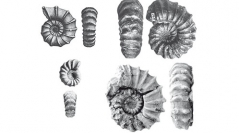

 Geodiversitas
29 (1) - Pages 87-117
Geodiversitas
29 (1) - Pages 87-117Phricodoceratidae is an original and rare Lower Jurassic family represented by the genus Phricodoceras Hyatt, 1900 which contains 10 species: P. taylori (Sowerby, 1826), P. lamellosum (Orbigny, 1844), P. urkuticum (Geczy, 1959), P. paronai (Bettoni, 1900), P. bettonii Geczy, 1976, P. venzoi Fantini Sestini, 1978, P. cornutum (Simpson, 1843), P. oistoides Geczy, 1976, P. imbricatum (Bettoni, 1900) and P. cantaluppii Fantini Sestini, 1978. It ranges from the Upper Sinemurian (Raricostatum Zone) to the Upper Pliensbachian (uppermost Margaritatus Zone-lowermost Spinatum Zone) corresponding to a range of about 6 to 7 millions years. Exhaustive results, based on the revision of the different species with their complete synonymy and on morphological, stratigraphical and paleogeographical approaches, allow to propose an evolutive history of the Phricodoceras. A cladistic interpretation sensu Dommergues & Meister (1999) and a proposition of sexual dimorphism where P. taylori ⇒ P. bettonii ⇒ P. venzoi may represent the microconchs and P. lamellosum ⇒ P. urkuticum ⇒ P. paronai the macroconchs are also given. Moreover, four hypothesis relating to their origin which still stay enigmatic are discussed.
Mollusca, Cephalopoda, Ammonitina, Phricodoceratidae, evolution, ontogeny, taxonomy, biostratigraphy, paleogeography, cladistic